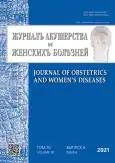在预防过程中的智力缺陷:正常还是病理学?
- 作者: Bezmenko A.A.1, Sadovaya N.D.1
-
隶属关系:
- Military Medical Academy named after S.M. Kirov
- 期: 卷 70, 编号 6 (2021)
- 页面: 5-12
- 栏目: Original study articles
- URL: https://journals.rcsi.science/jowd/article/view/70592
- DOI: https://doi.org/10.17816/JOWD70592
- ID: 70592
如何引用文章
详细
论证。近年来,随着分子遗传学诊断方法的积极发展,科学家们对肠道微生物区系的研究兴趣显著增加。一些科学论文已经确定了肠道微生物群在维持妊娠过程中的重要性,但关于这个问题的研究数量很少。
目的-评估孕妇肠道菌群的定性和定量组成。
材料与方法。这项研究涉及200名年龄在18至43岁之间、胎龄为6至22周的女性。所有孕妇均通过实时聚合酶链反应对肠道和阴道菌群状态进行定性和定量评估。
结果。在接受检查的孕妇中,100%检测到肠道菌群失调,而64.5%(n=129)的病例的菌群失调程度为I级,26.5%(n=53)为II级,9%(n=18)为III级。在所有孕妇中,常驻菌群对结肠的定植强度降低;此外,在中度和重度菌群失调的妇女中发现了条件致病菌Clostridium difficile,Enterobacter spp., Streptococcus spp. 和 Campylobacter spp.,数量超过正式允许值。对妊娠过程的分析表明,肠道菌群失调II或III度是早期复杂妊娠的危险因素(OR=0.2;p=0.00),这证明了肠道菌群失调在流产中的作用。
结论。妊娠是肠道菌群变化的易感因素,100%的孕妇检测到肠道菌群失调就证明了这一点。考虑到大多数正常妊娠的妇女被诊断为1级肠道菌群失调,可以认为这种程度的微生物失调是妊娠的正常现象。中度或重度肠道失调与复杂的早孕有关。
作者简介
Alexandr A. Bezmenko
Military Medical Academy named after S.M. Kirov
Email: bezmenko@yandex.ru
ORCID iD: 0000-0003-2837-1260
SPIN 代码: 8739-9920
MD, Cand. Sci. (Med.)
俄罗斯联邦, Saint PetersburgNatalya D. Sadovaya
Military Medical Academy named after S.M. Kirov
编辑信件的主要联系方式.
Email: nataliacrimea@gmail.com
ORCID iD: 0000-0003-3362-4402
SPIN 代码: 7063-7367
俄罗斯联邦, Saint Petersburg
参考
- Poluektova EA, Lyashenko OS, Shifrin OS, et al. Sovremennye metody izucheniya mikroflory zheludochno-kishechnogo trakta. Rossijskij zhurnal gastrojenterologii, gepatologii, koloproktologii. 2014;(2):85–91. (In Russ.)
- Yudin SM, Egorova AM, Makarov VV. Analysis of human microbiota. Russian and foreign experience. Mezhdunarodnyj zhurnal prikladnyh i fundamental’nyh issledovanij. 2018;(11):175–180. (In Russ.)
- Isolauri E, Kalliomaki M, Laitinen K, et al. Modulation of the maturing gut barrier and microbiota: a novel target in allergic disease. Curr Pharm Des. 2008;14(14):1368–1375. doi: 10.2174/138161208784480207
- Ott SJ, Musfeldt M, Wenderoth DF, et al. Reduction in diversity of the colonic mucosa associated bacterial microflora in patients with active inflammatory bowel disease. Gut. 2004;53(5):685–693. doi: 10.1136/gut.2003.025403
- Prakash S, Rodes L, Coussa-Charley M, et al. Gut microbiota: next frontier in understanding human health and development of biotherapeutics. Biologics. 2011;5:71–86. doi: 10.2147/BTT.S19099
- Proa AD, Albert PJ, Marshall T. Autoimmune disease in the era of the metagenome. Autoimmun Rev. 2009;8(8):677–681. doi: 10.1016/j.autrev.2009.02.016
- Rybalkina NS. The composition of the intestinal microflora in patients with increased body weight. Izvestiya Rossijskoj Voenno-medicinskoj akademii. 2018;37(1 S1–2);176–179. (In Russ.)
- Zhang D, Huang Y, Ye D. Intestinal dysbiosis: An emerging cause of pregnancy complications? Med Hypotheses. 2015;84(3):223–226. doi: 10.1016/j.mehy.2014.12.029
- Koren O, Goodrich JK, Cullender TC, et al. Host remodeling of the gut microbiome and metabolic changes during pregnancy. Cell. 2012;150:470–480. doi: 10.1016/j.cell.2012.07.008
- Freemark M. Placental hormones and the control of fetal growth. J Clin Endocrinol Metab. 2010;95(5):2054–2057. doi: 10.1210/jc.2010-0517
- Newbern D, Freemark M. Placental hormones and the control of maternal metabolism and fetal growth. Curr Opin Endocrinol Diabetes Obes. 2011;18(6):409–416. doi: 10.1097/MED.0b013e32834c800d
- Trowsdale J, Betz AG. Mother’s little helpers: mechanisms of maternal-fetal tolerance. Nat Immunol. 2006;7(3):241–246. doi: 10.1038/ni1317
- Nelson SM, Matthews P, Poston L. Maternal metabolism and obesity:modifiable determinants of pregnancy outcome. Hum Reprod Update. 2010;16(3):255–275. doi: 10.1093/humupd/dmp050
- Redman CW, Sargent IL. Latest advances in understanding preeclampsia. Science. 2005;308(5728):1592–1594. doi: 10.1126/science.1111726
- Noris M, Perico N, Remuzzi G. Mechanisms of disease: pre-eclampsia. Nat Clin Pract Nephrol. 2005;1(2):98–120. doi: 10.1038/ncpneph0035
- Spaanderman M, Ekhart Timo, Eycket van Jim, et al. Preeclampsia and maladaptation to pregnancy: a role for atrial natriuretic peptide? Kidney Int. 2001;60(4):1397–1406. doi: 10.1046/j.1523-1755.2001.00943.x
- Young BC, Levine RJ, Karumanchi SA. Pathogenesis of preeclampsia. Annu Rev Pathol. 2010;5:173–192. doi: 10.1146/annurev-pathol-121808-102149
- Taddei CR, Cortez RV, Mattar R, et al. Microbiome in normal and pathological pregnancies: A literature overview. Am J Reprod Immunol. 2018;80(2):e12993. doi: 10.1111/aji.12993
- Soderborg TK, Clark SE, Mulligan CE, et al. The gut microbiota in infants of obese mothers increases inflammation and susceptibility to NAFLD. Nat Commun. 2018;9(1):4462. doi: 10.1038/s41467-018-06929-0
- Lv LJ, Li Sheng-Hui, Li Shao-Chuan, et al. Early-onset preeclampsia is associated with gut microbial alterations in antepartum and postpartum women. Front Cell Infect Microbiol. 2019;9:224. doi: 10.3389/fcimb.2019.00224
- Baldassarre ME, Di Mauro A, Capozza M, et al. Dysbiosis and prematurity: is there a role for probiotics? Nutrients. 2019;11(6):1273. doi: 10.3390/nu11061273
- Patent RF na izobretenie RU2742110S1 / 02.02.2021. Bjul. No. 4. Ruhljada NN, Vinnikova SV, Cechoeva LSh, Luft VM. Sposob diagnostiki sostojanija mikroflory vlagalishha i kishechnika u zhenshhin s oslozhnennoj beremennost’ju.
- Gapon MN, Zarubinsky VYa, Polishchuk IS, Kaplienko LP. Local cytokine status in pregnantwomen with intestinal dysbiosis. Medicus. 2016;(6):58–61. (In Russ.)
- Polishchuk IS, Gapon MN, Ternovskaya LN. The nature of the colon microbiocenosis of pregnant. Aktual’nye voprosy diagnostiki i profilaktiki infekcionnyh i parazitarnyh zabolevanii na yuge Rossii. (Conference proceedings) Materialy mezhregional’noi nauchno-prakticheskoi konferencii s mezhdunarodnym uchastiem. Oct 13–14. Rostov-on-Don; 2016: 274–278. (In Russ.)
- Seythanova BT, Shapambaev NC, Olzhayeva RR, Kalmenova PE. Microbiocenosis vagina and intestine of pregnant women. Nauka i zdravoohranenie. 2014;(1):70–71. (In Russ.)
- Popkova SM, Rakova EB, Khramova EE, et al. Microecological combinations of vaginal and intestinal biotopes in women with lower female reproductive tract inflammantory diseases and in adolescents girls with ovarian dysfunction. Bull Sib Otd Ross Akad Med Nauk. 2013;33(4):77–83. (In Russ.)
- Aylamazyan EK, Shipitsyna EV, Savicheva AМ. Woman’s microbiota and pregnancy outcomes. Journal of Obstetrics and Women’s Diseases. 2016;65(4):6–14. (In Russ.). doi: 10.17816/JOWD6546-14
- Kira EF. Probiotics in the restoration of vaginal microbiocenosis. Obstetrics and Gynecology. 2017;(5):32–38. (In Russ.). doi: 10.18565/aig.2017.5.32-8
- Molchanov OL, Kira EF. Microecosystem of the vagina. Features of normal functioning. Obstetrics and Gynaecology of Saint Petersburg. 2018;(1):65–68. (In Russ.)
- Karpeev SA. Maloizuchennye aspekty privychnogo nevynashivaniya beremennosti. In: Aktual’nye voprosy pediatrii i perinatologii: sbornik rabot, posvyashchennyi 35-letiyu FGBU “SZFMIC im. V.A. Almazova. Ed. by D.O. Ivanov, V.P. Novikova, I.A. Leonova. Saint Petersburg: InformMed; 2015. P. 69–85. (In Russ.)
- Savchenko TN, Khashukoyeva AZ, Kamoyeva SV, et al. The relationship of microbiocenosis of mucous membranes of genital and digestive systems with miscarriage in women. Lechenie i profilaktika. 2013;(2):36–42. (In Russ.)








